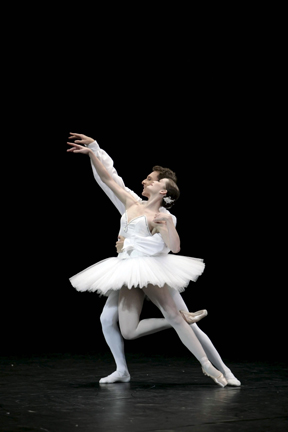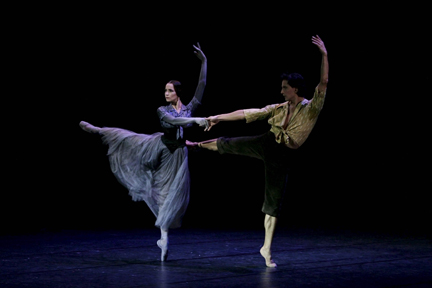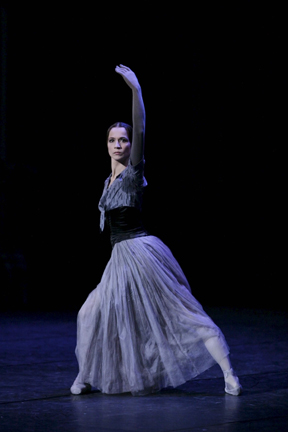Neoclassicism in Paris
Lifar – Malandain
Paris Opera Ballet
Palais Garnier,
Paris
October 21-22, 2006
by Marc Haegeman
copyright 2006 by Marc Haegeman
 Serge Lifar (1905-1986), Ukranian and the last favourite of Diaghilev, directed the Paris Opera Ballet for almost thirty years until 1958. He was an influential dancer and a prolific choreographer, a notable dance theoretician and a tireless crusader for the values of neoclassical ballet, he had a keen eye for spotting talent, knew as none else how to bring out the personalities of his dancers and successfully reinvigorated the company’s repertory and its standard. Yet for all that, the man is now more myth than reality, his ballets are often excused as passé, and unfortunately the public rarely ever comes to see anything substantial of his work outside of anniversaries or other special occasions.
Serge Lifar (1905-1986), Ukranian and the last favourite of Diaghilev, directed the Paris Opera Ballet for almost thirty years until 1958. He was an influential dancer and a prolific choreographer, a notable dance theoretician and a tireless crusader for the values of neoclassical ballet, he had a keen eye for spotting talent, knew as none else how to bring out the personalities of his dancers and successfully reinvigorated the company’s repertory and its standard. Yet for all that, the man is now more myth than reality, his ballets are often excused as passé, and unfortunately the public rarely ever comes to see anything substantial of his work outside of anniversaries or other special occasions.
A programme dedicated to Serge Lifar, like the second offering of the current season in Paris, reviving two of his most acclaimed ballets “Suite en Blanc” and “Les Mirages”, is therefore most welcome. A Lifar triple bill to commemorate the 20th anniversary of his death would have been too obvious, I suppose; instead dance director Brigitte Lefèvre preferred to illustrate the dialogue between works from past and present by bringing in a contemporary creation by Thierry Malandain, bravely exploring, like Lifar, the aesthetics of classicism.
The opening “Suite en Blanc” created in 1943 is as much a tribute to the Paris Opera School and the company as it is to Lifar’s own ideas about neoclassical dance. A plotless virtuosic divertissement, it’s moreover a cleverly orchestrated piece of grand theatre, of a kind hardly ever seen these days, yet ideally suited for this company and its venue, the sumptuous Palais Garnier. The fragments from Edouard Lalo’s ravishing music for the ballet “Namouna” seem tailor-made, from the intense, almost too dramatic orchestral overture which prepares for something big, to the handpicked variations brimming with sparkle and character. The opening scene with the ensemble of thirty-seven dancers in white placed in various dispositions covering the stage and the background platform is a vision of immense beauty — equaled only, perhaps, by the “Grand Défilé”.
It was great to see that “Suite en Blanc” is danced with superb conviction by most, although it remains more than anything étoile territory. Lifar himself defined his Suite as “a true parade of étoiles”. In a first cast we had an impeccable Jean-Guillaume Bart in the Mazurka, an ideally matched Aurélie Dupont and Manuel Legris, sensitive and full of yearning in the pas de deux, and an imperial Agnès Letestu in La Cigarette (although première danseuse Emilie Cozette in a second cast gave an equally impressive, more flexible rendering). In a second cast Clairemarie Osta impressively demonstrated musicality, stamina and chic in the daunting La Flûte, while Nicolas Le Riche danced the Mazurka with plenty of swagger. Of the younger generations, next to Cozette, Fanny Fiat, Myriam Ould-Braham and Laura Hecquet looked most promising.
 Thierry Malandain is director of Ballet Biarritz in Southern France. As a choreographer who still values classicism he undoubtedly belongs to a dying species on the contemporary French dance scene. With his first creation for the Paris Opera, “L’Envol d’Icare” set to the magnificent “Concert for Piano and Strings” by Alfred Schnittke, there was no question of doing Lifar over again, even if the title clearly refers to the old master’s famous “Icare”. It was more an attempt to further illustrate the diversity of directions neoclassical ballet can take. Unfortunately, sandwiched between the Lifar ballets, Malandain’s “L’Envol d’Icare” cut a rather slight figure which might have been avoided had it been shown in another context.
Thierry Malandain is director of Ballet Biarritz in Southern France. As a choreographer who still values classicism he undoubtedly belongs to a dying species on the contemporary French dance scene. With his first creation for the Paris Opera, “L’Envol d’Icare” set to the magnificent “Concert for Piano and Strings” by Alfred Schnittke, there was no question of doing Lifar over again, even if the title clearly refers to the old master’s famous “Icare”. It was more an attempt to further illustrate the diversity of directions neoclassical ballet can take. Unfortunately, sandwiched between the Lifar ballets, Malandain’s “L’Envol d’Icare” cut a rather slight figure which might have been avoided had it been shown in another context.
The piece gave the impression of being in a state of incompleteness, with plenty of ideas—more than anything revealed by the notes in the program book—still waiting to be organised. There are recognisable snippets of the Icarus myth, as a metaphor for man trying to defy gravity and aspiring for the light, just as there are traces of classical steps in Malandain’s choreography. Seven couples moved in circles, in lines, then in duos, in the same monotonous fashion for some 25 minutes, grounded by Malandain’s inability to use the changing atmosphere of the music for anything else than the rhythm. And just as the otherwise powerful Benjamin Pech ends up like a beached whale on one of the borders of Alain Lagarde’s wavelike-labyrinth, this “Envol d’Icare” never really takes flight.
 How to tell a story was otherwise demonstrated by “Les Mirages”. It had been more than fifteen years since this ballet was last seen at the Paris Opera (although by 1990 it had reached its 200th performance). Miraculously, dancers who were cast then are still around. One of them was Kader Belarbi, now one of the veteran male étoiles but still radiant as no one else in the leading role of the Young Man. (I didn’t see Manuel Legris, who also danced the role in the previous run). And, miraculously as well, the ballet still knows to inspire the current generation of dancers to outstanding performances.
How to tell a story was otherwise demonstrated by “Les Mirages”. It had been more than fifteen years since this ballet was last seen at the Paris Opera (although by 1990 it had reached its 200th performance). Miraculously, dancers who were cast then are still around. One of them was Kader Belarbi, now one of the veteran male étoiles but still radiant as no one else in the leading role of the Young Man. (I didn’t see Manuel Legris, who also danced the role in the previous run). And, miraculously as well, the ballet still knows to inspire the current generation of dancers to outstanding performances.
“Les Mirages” was, like “Suite en Blanc,” created during the war but, due to various circumstances (among others Lifar’s eviction from the Opera following accusations of collaboration with the Germans), the premiere had to wait until 1947. Intensely dramatic, although eventually less pessimistic than its subject—life seen as a succession of illusions only resulting in loneliness—might lead to believe at first sight, “Les Mirages” is a child of its time. It is, however, also a work of rare expressiveness and dramatic power, and another convincing manifesto of neoclassical choreography. It boasts some superbly constructed duets and the variation for the Shadow quickly became an anthology piece.
“Les Mirages” is firmly rooted in the Ballets russes tradition. Lifar surrounded himself with distinguished artists like the designer Adolphe Mourron ‘Cassandre’ who had made a name for himself with his art deco publicity posters in the 1920s and the composer Henri Sauguet who previously worked with Diaghilev and Boris Kochno, to produce with “Les Mirages” a Gesamtkunstwerk with a powerful visual as well as aural impact. With the exception of the leading couple Cassandre’s unabashedly naïve costumes undoubtedly show their age, but with his renaissance palazzo décor which really seems the gate towards a dream world, they create this special atmosphere which makes “Les Mirages” such a unique balletic and theatrical experience. On the other hand, Lifar knew to characterise his dreamlike figures in such a convincing way by pure dance—a quality regrettably absent in Malandain’s piece—that there is no doubt they would still register without their old-fashioned costumes.
 As “Suite en Blanc” “Mirages” was danced brilliantly by the company, with especially fine performances from the two leads: Kader Belarbi and a magnificent Delphine Moussin as his Shadow, a role created by Yvette Chauviré. Moussin, one of the company’s genuine classical ballerinas—and finally étoile since last year—effortlessly blended mysteriousness with feminine vulnerability. Belarbi gave a moving performance as the Young Man vainly pursuing his dreams of youth, wealth, and love. Their final intense duet at dawn, after the palace has vanished, was a not only a stunning climax but also a sublime moment of neoclassical dance.
As “Suite en Blanc” “Mirages” was danced brilliantly by the company, with especially fine performances from the two leads: Kader Belarbi and a magnificent Delphine Moussin as his Shadow, a role created by Yvette Chauviré. Moussin, one of the company’s genuine classical ballerinas—and finally étoile since last year—effortlessly blended mysteriousness with feminine vulnerability. Belarbi gave a moving performance as the Young Man vainly pursuing his dreams of youth, wealth, and love. Their final intense duet at dawn, after the palace has vanished, was a not only a stunning climax but also a sublime moment of neoclassical dance.
Agnès Letestu danced in a second cast undoubtedly more precise than Moussin, but I found her dramatically less subtle and at times she seemed to overwhelm Karl Paquette’s Young Man by her imposing stature and her merciless and ice-cold presence. There were excellent supporting roles by Emilie Cozette and, again, a musical and sparkling Myriam Ould-Braham.
Vello Pähn led the Orchestra of the Opera with plenty of mastery through three complex but rich scores that form for all three works an integral part of the performance. Members of the French press have been writing in predictable condescending terms about this revival of Lifar at the Paris Opera. Yet, by including a contemporary creation, this triple bill has sufficiently proven that a more frequent confrontation with the historic repertoire and the great old masters is more than wanted.
Photos, from top, all by Sébastien Mathé:
Aurélie Dupont and Manuel Legris in Lifar's "Suite en blanc."
Benjamin Pech in Thierry Malandain's "L' Envol d'Icare".
Kader Belarbi and Delphine Moussin in Lifar's "Les Mirages."
Delphine Moussin in Lifar's "Les Mirages."
Volume 4, No. 39
November 6, 2006
copyright ©2006 Marc Haegeman
www.danceviewtimes.com